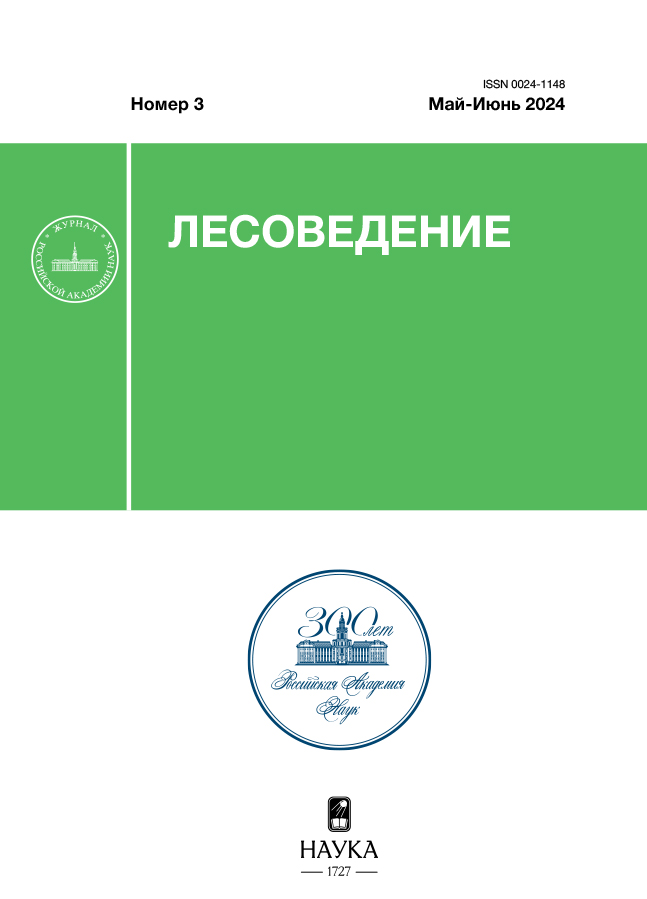The flora of silver birch shelter belts in the vicinity of the Ufa city
- Autores: Ishbirdina L.M.1, Timer’yanov A.S.1, Odintsov G.E.1, Gabitova A.А.1
-
Afiliações:
- Bashkir State Agrarian University
- Edição: Nº 3 (2024)
- Páginas: 265-274
- Seção: RESEARCH
- URL: https://ruspoj.com/0024-1148/article/view/681315
- DOI: https://doi.org/10.31857/S0024114824030054
- EDN: https://elibrary.ru/PECVEP
- ID: 681315
Citar
Texto integral
Resumo
The paper presents the results of a study of the flora of shelter belts comprised of: silver birch (Betula pendula Roth), silver birch and heart-shaped linden (Tilia cordata Mill.), silver birch and apple trees (Malus sylvestris Mill.), silver birch and Scots pine (Pinus sylvestris L.), silver birch and balsam poplar (Populus balsamifera L.) in the vicinity of the Ufa city. It was revealed that there exists a large species diversity of flora in shelter belts with silver birch, significantly exceeding the species diversity of shelter belts with balsam poplar in the same study area. The leading families in the flora of shelterbelts with silver birch were Asteraceae, Rosaceae, Fabaceae, Apiaceae, and Poaceae. The “ruderal” and “semi-ruderal” families are also well represented: Brassicaceae, Caryophyllaceae, Lamiaceae. The flora of shelter belts is dominated by meadow, meadow-ruderal species and species of broadleaved forests and their fringes. At the same time, in older, sparser and taller shelter belts, the number of meadow and ruderal species increases with an increase in the amount of light passing through the canopy. Under the conditions of low anthropogenic load, the proportion of broadleaved forest species and their synanthropized variants increases with the age of shelter belts. The predominance of species with a wide range of hemeroby accommodation — oligo-meso-β-euhemerobes — has also been established, but with the tree canopy getting sparser, the dominant position passes to species that are more resistant to anthropogenic influence — meso-euhemerobes. At high anthropogenic loads, the participation of euhemerobes increases. In shelter belts of pure birch, birch and linden, birch and apple trees, undergrowth and juvenile specimens of silver birch were found. There is no regeneration of birch in forest belts with birch and balsam poplar.
Palavras-chave
Texto integral
Sobre autores
L. Ishbirdina
Bashkir State Agrarian University
Autor responsável pela correspondência
Email: butomus11@yandex.ru
Rússia, 50-letiya Oktyabrya st. 34, Ufa, 450001
A. Timer’yanov
Bashkir State Agrarian University
Email: butomus11@yandex.ru
Rússia, 50-letiya Oktyabrya st. 34, Ufa, 450001
G. Odintsov
Bashkir State Agrarian University
Email: butomus11@yandex.ru
Rússia, 50-letiya Oktyabrya st. 34, Ufa, 450001
A. Gabitova
Bashkir State Agrarian University
Email: butomus11@yandex.ru
Rússia, 50-letiya Oktyabrya st. 34, Ufa, 450001
Bibliografia
- Czerepanov S. K., Vascular plants of Russia and adjacent states (the former USSR), Cambridge: Cambridge university press, 1995, 516 p.
- Frank D., Klotz S., Klotz S., Biologisch-öekologische Daten zur Flora der DDR, Halle (Saale), 1990, 167 p.
- Ishbirdina L. M., Timer’yanov A.S., Odintsov G. E., Flora lesopolos s topolem bal’zamicheskim (Populus balsamifera L.) v okrestnostyakh goroda Ufy (The flora of the forest belt with balsam poplar (Populus balsamifera L.) in the vicinity of the city of Ufa), Trudy Sankt-Peterburgskogo nauchno-issledovatel’skogo instituta lesnogo khozyaistva, 2019, no. 2, pp. 4—22.
- Kadil’nikov I.P., Fiziko-geograficheskoe raionirovanie Bashkirskoi ASSR (Physico-geographical zoning of the Bashkir Autonomous Soviet Socialist Republic), Ufa: Bashkirskii gos. un-t, 1964, 210 p.
- Klotz S., Die ruderalgesselschaften eines neubaugebietes — ihre verbeitung und combination, Acta Bot. Slov. Acad. Sci. Slovacae, 1984, no. 1, pp. 111—125.
- Krasheninnikov I. M., Kucherovskaya-Rozhanets S.E., Prirodnye resursy Bashkirskoi ASSR (Natural resources of the Bashkir Autonomous Soviet Socialist Republic), Leningrad: Izd-vo AN SSSR, 1941, vol. 1: Vegetation of the Bashkir Autonomous Soviet Socialist Republic, 155 p.
- Kunick D., Zonietung des Stadtgebietes von Berlin (West). Ergebnisse Floristischer Untersuchung, Gen. Schriftenr. d.Fachber. Landschaftsentwicklung u.Umweltforsch, 1982, no. 14, pp. 1—164.
- Metody izucheniya lesnykh soobshchestv (Methods of forest communities study), Saint Petersburg: Izd-vo NII Khimii SPbGU, 2002, 240 p.
- OST 56-69-83 (Industrial standart), Moscow: TsBNTI Gosleskhoza SSSR, 1983, 60 p.
- Raunkiær C., The life forms of plant and statistical plant geography, Oxford: Clarendon Press, 1934, 632 p.
Arquivos suplementares














